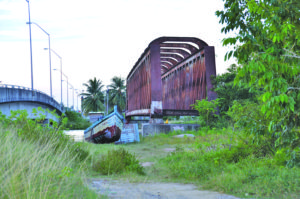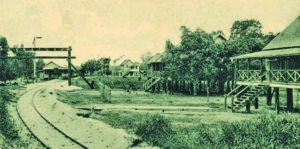In October 1845, a management committee was appointed to supervise the construction of the project. Eventually, a bill proposing the construction of the railway was passed by the Court of Policy in July 1846. Then in March 1847, Frederick Catherwood began his task of building the railway.


For the Georgetown’s terminus, the Demerara Railway Company purchased an area at the junction of Main and Lamaha Streets in the city. Here, in August 1847 work commenced on the building of a large railway station with workshops, coal sheds and large water tanks. Construction other stations along the route also started shortly after.
That same year three railway steam engines, purchased in London, arrived in Georgetown and they were, respectively, named “Mosquito”, “Sandfly” and “Firefly”.
At first, a shortage of labour and finances impeded the construction of the railway. As construction continued, the cost escalated and government intervention was necessary to assure the repayment of loans offered. But despite such problems, after nearly 15 months the railway was opened as far as Plaisance on 3 November 1848 with two trains running daily between this village and Georgetown. This became the first railway system on the South American continent.
Further problems arose as the railway extended, since land was required by the company for the route through the various plantations and the proprietors were not willing to give up any part of their property without obtaining a favourable price. But through the intervention of the government, an agreement was reached by which proprietors were paid a compensation of $40 per acre of land utilised for the railway.
By May 1849, the railway company became dissatisfied with the service provided by Catherwood and his contract was terminated and this led to a further delay in construction. Financial problems, however, was the main cause but this was remedied when the government in July 1849 approved a loan of 50,000 pounds to the company. Construction supervised by Mr. Manifold, Catherwood’s assistant, then moved quickly and the railway line reached Buxton in March 1850, Enmore in October 1850 and Belfield in November 1850.
The following year the company was again plagued by financial problems with the result that worked almost grounded to a halt and there was little progress for almost two years. The situation was so serious, the Demerara Railway Company’s committee resigned and Manifold was left in charge of all affairs. Again, the government intervened ease financial pressure on the company through a special ordinance in 1853 which reduced the rate of interest on the 50,000-pound loan from 6 percent to 4 percent annually.
Work recommenced at a rapid pace and the line reached Two Friends in October 1854. There followed another slowing down of the project, again due to the shortage of funds. As before, the government had to come to the rescue. On 1 August 1863, the railway reached Clonbrook and, finally, the Mahaica terminus at Helena in August 1864.
On 31 August 1864, the Governor, Sir Francis Hincks, formally declared the railroad open. Its length was nearly twenty-two miles and the total cost of construction was estimated to be 313,890 pounds. Of this figure the Demerara Railway Company raised 249,023 pounds while the remaining sum of 64,867 pounds was acquired through government loans.
The railway was very popular among the people on the East Coast Demerara, and soon there were demands for it to be extended further to Rosignol on the west bank of the Berbice River, 62 “railway” miles east of Georgetown. But it was not until 1890 that the government granted a contract to the Demerara Railway Company to build the line between Mahaica and Rosignol, and also another line between Vreed-en-Hoop and Tuschen west of the Demerara River.
The extension to Rosignol was constructed from 1897 to 1900 and its terminus was the ferry stelling on the left bank of the Berbice River, thus allowing for easy connection by ferry steamer across the river with New Amsterdam. This part of the project included the building of sturdy iron railway bridges across the Mahaica, Mahaicony and Abary Rivers.
The first section of the Demerara-Essequibo railway was laid down after 1900 between Vreed-en-Hoop and Greenwich Park, and later extended to Parika in 1914.
The Demerara Railway Company was later sold to the Colonial Transport Department of the government, which took over control of the railway services from January 1, 1922.
The railway not only helped in quick and easy movement of the travelling public, but it also transported large quantities of goods very efficiently. Bulk sugar from the estates was moved with relative ease to Georgetown for export. But despite the popularity of the railway, many sugar estate owners, at first, were wary of it for a particular reason. They felt it would encourage their workers to abandon their jobs on the estates and settle on lands near the railway and become peasant farmers. The movement of people to live and farm in the vicinity of the railway did occur, but this did not pull away workers from the sugar estates as the estate owners feared. Text from “The Guyana Story – From Earliest Times to Independence” by veteran retired Guyanese diplomat, Dr Odeen Ishmael)



